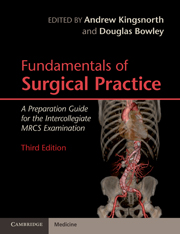Book contents
- Frontmatter
- Contents
- List of contributors
- Preface
- Section 1 Basic Sciences Relevant to Surgical Practice
- 1 Pharmacology and the safe prescribing of drugs
- 2 Fundamentals of general pathology
- 3 Fundamentals of surgical microbiology
- 4 Fundamentals of radiology
- Section 2 Basic Surgical Skills
- Section 3 The Assessment and Management of the Surgical Patient
- Section 4 Perioperative Care of the Surgical Patient
- Section 5 Common Surgical Conditions
- Index
- References
3 - Fundamentals of surgical microbiology
Published online by Cambridge University Press: 03 May 2011
- Frontmatter
- Contents
- List of contributors
- Preface
- Section 1 Basic Sciences Relevant to Surgical Practice
- 1 Pharmacology and the safe prescribing of drugs
- 2 Fundamentals of general pathology
- 3 Fundamentals of surgical microbiology
- 4 Fundamentals of radiology
- Section 2 Basic Surgical Skills
- Section 3 The Assessment and Management of the Surgical Patient
- Section 4 Perioperative Care of the Surgical Patient
- Section 5 Common Surgical Conditions
- Index
- References
Summary
Bacteriology for surgeons
Microbiology testing is increasingly automated with same-day PCR tests for organisms such as MRSA and C. difficile now widely available. Despite these advances, the pus and tissue samples of most interest to surgeons take at least two days to produce full culture and sensitivity results. There is good evidence that appropriate early antibiotics reduces morbidity in septic shock, and 8 hours delay is associated with an approximately 10-fold increase in mortality. Treatment of severe surgical infections therefore requires an empirical choice of antibiotics, based on knowledge of local flora and resistance rates. If the sample is sent immediately for microscopy, the regimen can be amended on day one if necessary. A basic knowledge of bacterial taxonomy will enable the surgical trainee to understand why different antibiotics are required in different situations, and to refine empirical therapy as supplementary results become available.
The Gram stain
First devised in 1844, this staining technique is still fundamental to bacteriology today. It allows prediction of the cause of infection within minutes, and at minimal cost. Laboratories base subsequent biochemical identification and susceptibility testing on the initial Gram stain of the surgical sample, so it is crucial that samples are collected carefully, and transported promptly.
- Type
- Chapter
- Information
- Fundamentals of Surgical PracticeA Preparation Guide for the Intercollegiate MRCS Examination, pp. 41 - 53Publisher: Cambridge University PressPrint publication year: 2011

